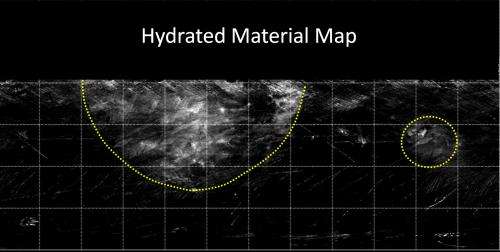Dawn suggests special delivery of hydrated material to Vesta

(Phys.org)—The mechanism by which water is incorporated into the terrestrial planets is a matter of extensive debate for planetary scientists. Now, observations of Vesta by NASA's Dawn mission suggest that hydrous materials were delivered to the giant asteroid mainly through a build-up of small particles during an epoch when the Solar System was rich in dust. This is a radically different process from the way in which hydrous materials are deposited on the moon and may have implications for the formation of terrestrial planets, including the delivery of the water that forms Earth's oceans. Maria Cristina De Sanctis and the Dawn team will present the scenarios at the European Planetary Science Congress in Madrid on Wednesday 26th September.
De Sanctis, of the Institute of Astrophysics and Space Planetology in Rome, said, 'Vesta's surface shows distinct areas enriched with hydrated materials. These regions are not dependent on solar illumination or temperature, as we find in the case of the Moon. The uneven distribution is unexpected and indicates ancient processes that differ from those believed to be responsible for delivering water to other airless bodies, like the Moon.'
A team led by De Sanctis studied data from Dawn's visible and infrared (VIR) mapping spectrometer. Analysis showed large regional concentrations of hydroxyl – a hydrogen and an oxygen atom bound together – clearly associated with geological features including ancient, highly-cratered terrains and the Oppia crater.
Hydroxyl on the surface of the Moon is thought to be created continuously by the interaction of protons from the solar wind with the lunar regolith. Highest concentrations are found in areas near the lunar poles and in permanently shadowed crater where it is very cold. By contrast, the distribution of hydroxyl on Vesta is not dependent on significant shadowing or unusual cold temperatures. It is also stable over time, so its origin does not appear to be due to short-term processes.
The hydroxyl-rich regions on Vesta broadly correspond to its oldest surfaces. Around relatively large and young impact craters, hydroxyl detections are weak or absent, suggesting that the delivery of hydroxyl is not an ongoing process.
The evidence from VIR suggests that much of Vesta's hydroxyl was delivered by small particles of primitive material, less than a few centimeters in diameter, over a time-limited period. This period may have occurred during the primordial solar system, around the time it is believed water was accreted on Earth, or during the Late Heavy Bombardment, when collisions would have produced a significant amount of primitive material dust.
However, this is not the whole story of hydrous materials on Vesta. The Oppia Crater is hydroxyl-rich, but not covered with the primitive material. This suggests that there is more than one mechanism at work for depositing hydroxyl on Vesta's surface.
De Sanctis said, 'The origin of Vesta's hydroxyl is certainly complex and possibly not unique: there could be various sources, like formation of hydroxyl actually on Vesta, in addition to the primordial impactors. Vesta is providing new insights into the delivery of hydrous materials in the main asteroid belt, and may offer new scenarios on the delivery of hydrous minerals in the inner Solar System, suggesting processes that may have played a role in the formation of terrestrial planets.'
Provided by Europlanet





















